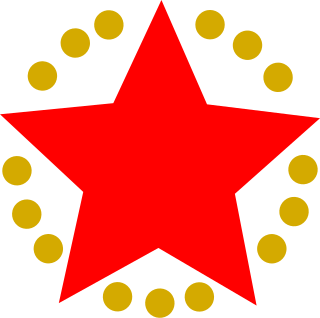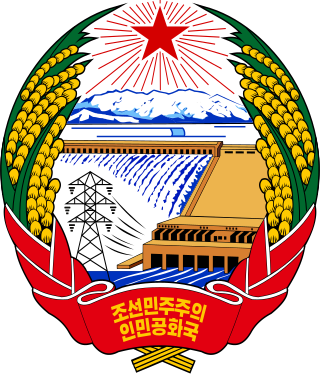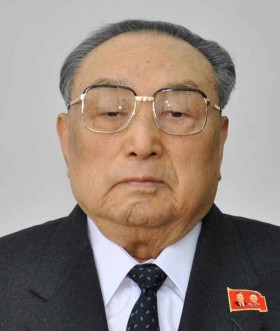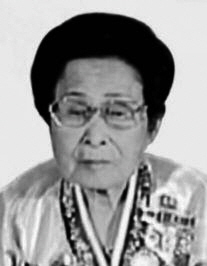
Kim Yong-nam is a North Korean retired politician who served as the President of the Presidium of the Supreme People's Assembly of North Korea, from 1998 until 2019. Previously, he served as Minister of Foreign Affairs from 1983 to 1998. He was elected a member of the Presidium of the Workers' Party of Korea (WPK) in 2010.

The Korean Central News Agency (KCNA) is the state news agency of North Korea. The agency portrays the views of the North Korean government for both domestic and foreign consumption. It was established on December 5, 1946, and now features online coverage.

The Supreme People's Assembly is the legislature of North Korea. It is ostensibly the highest organ of state power and the only branch of government in North Korea, with all state organs subservient to it under the principle of unified power. However, in practice it is a rubber stamp legislature which exists to approve decisions made by the ruling party as a formality, and which has little to no real power of its own.
The Democratic Front for the Reunification of Korea (DFRK), also known as the Democratic Front for the Reunification of the Fatherland (DFRF) or the Fatherland Front, was a North Korean popular front formed on 25 June 1949 and led by the Workers' Party of Korea (WPK). It was initially called the Fatherland United Democratic Front.

In the North Korean government, the Cabinet is the administrative and executive body. The North Korean government consists of three branches: administrative, legislative, and judicial. However, they are not independent of each other, but all branches are under the exclusive political leadership of the Workers' Party of Korea (WPK).

Jo Myong-rok was a North Korean military officer who held the military rank Chasu. In 1998, he was appointed first vice-chairman of the National Defence Commission of North Korea, Director of the Korean People's Army General Political Bureau. Previously, he was the commander of the air defence forces.

The North Korean judicial system is based on the Soviet model. It includes the Central Court of the Democratic People's Republic of Korea, Provincial and special-city level Courts, local People's Courts, and Special Courts.

Kim Il was a North Korean politician who was served as Premier of North Korea from 28 December 1972 to 19 April 1976.
The award system of the Democratic People's Republic of Korea was initially created less than one month after the foundation of the Republic. During the years of Japanese occupation of Korea, many of the future leaders fled to the Soviet Union. During World War II many if not close to all party leaders and Korean People's Army commanders served in the Soviet Army and as such adopted many of the Soviet awards criteria for their own. During the late 1940s and until the Sino-Soviet Split in late 1958, orders and titles were made in the Soviet Money Mints in Moscow or Leningrad. Soviet made awards were modeled after Soviet orders and made of sterling silver. Initially the orders were attached to clothing with a screw-plate, but after Soviet production stopped, production was moved to North Korea. The screwback was replaced with a pin and the silver content was replaced with cheap tin. With the exception of a few examples of modern orders, Soviet and Czech KPA awards are the most sought after in current militaria markets.

Kim Yong Ju was a North Korean politician and the younger brother of Kim Il Sung, who ruled North Korea from 1948 to 1994. Under his brother's rule, Kim Yong Ju held key posts including Politburo member in the Workers' Party of Korea (WPK) during the 1960s and early 1970s, but he fell out of favour in 1974 following a power struggle with Kim Jong Il. From 1998 until his death in 2021, he held the ceremonial position of Honorary Vice President of the Presidium of the Supreme People's Assembly (SPA), North Korea's parliament.

The Cabinet of Democratic People's Republic of Korea is the supreme administrative organ of North Korea. The Cabinet's official newspaper is Minju Choson.

Kim Won-gyun was a North Korean composer and politician. He is considered one of the most prominent, if not the most celebrated, composer of North Korea. He composed "Aegukka" — the national anthem of the country — and "Song of General Kim Il-sung", in addition to revolutionary operas.

The chairman of the Standing Committee of the Supreme People's Assembly, formerly known as the president of the Presidium of the Supreme People's Assembly, is the presiding officer of the Standing Committee of the Supreme People's Assembly, which is the permanent body of the Supreme People's Assembly, North Korea's highest organ of state power.

Upon its liberation in 1945 and subsequent foundation in 1948, North Korea adopted national symbols distinct from the national symbols of South Korea. The traditional flag of Korea, the Taegukgi, and the symbol Taeguk, were swapped for socialist symbols.

Ri Su-yong, also known as Ri Chol (이철), is a North Korean diplomat and politician, serving as the Minister of Foreign Affairs of North Korea from April 2014 until May 2016.

The Vice Premier of the Cabinet assists the Premier of North Korea in guiding the work of the Cabinet of North Korea. The office is also alternatively known as Deputy Prime Minister of North Korea.

Kim Rak-hui was a North Korean politician. Kim worked in the agricultural and cooperatives section for most of her working life. During the Korean War, her efforts in rationing caught the attention of Kim Il Sung. Many time delegate to the Supreme People's Assembly (SPA), Kim Rak-hui rose in the ranks of the Workers' Party of Korea (WPK), becoming a full member of its Central Committee in 1970. She was appointed to the Politburo of the Workers' Party of Korea in 2010 and became one of six Vice Premiers of North Korea that year. She ran a committee to combat epizootic diseases.

Hwang Sun-hui was a North Korean politician who served in several high-ranking positions in the Workers' Party of Korea (WPK), including in the Supreme People's Assembly and the Central Committee of the WPK. She was affiliated with the Korean Revolution Museum from 1965, and was its director from 1990.
The Workers' Party of Korea Publishing House is the principal publishing house of the Workers' Party of Korea (WPK) and one of the two main publishers in the country. It publishes magazines and books on politics, such as the works of Kim Il Sung and Kim Jong Il, posters and works of fiction. The current director-general and editor-in-chief is Ri Yong-chol.

The vice chairman of the Standing Committee of the Supreme People's Assembly is one of the members that form the Standing Committee of the Supreme People's Assembly. The vice chairman of the SPA Standing Committee is elected by the Supreme People's Assembly alongside the SPA Standing Committee's chairman, secretary general and members. From 1972 until 1998, the vice chairman of the SPA Standing Committee was concurrently the vice chairman of the Supreme People's Assembly.

















